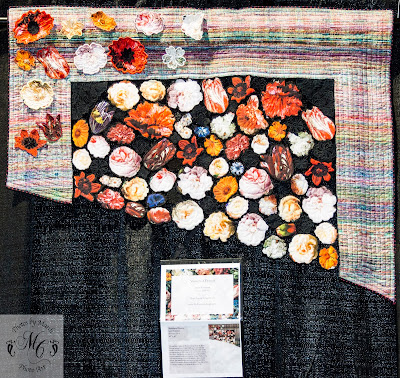 |
| This is the closest I'll ever get to a bear. They can be a nuisance, but they are fun to see wandering the neighborhood. It was a tragic end to two of "our" animals. |
When anxious, return to quilting. Quilting and sewing keep a person on their toes. They say that using the brain and solving problems keeps it functioning well, and forestalls age-related deterioration. At this rate I think my brain should last at least 150 years!
My cork board ironing board is fantastic.
 |
| See how nicely the pins hold in the cork board? You can see the glue on the back side of block, but it will wash out later when I block the quilt. |
I wrote about my shrunken ironing board cover. Apparently I didn't shrink the canvas when I made it a couple of years ago. When it got looking grungy I just turned it over. When I renovated the table top with cork board I washed the cover and it shrunk up irretrievably, so I had to make a new one. This time I washed the new piece of canvas first and made the cover. It fits the table top, but is a bit looser that I really want. If I had not washed it, I could have spritzed it with water so it would shrink down to the table top. The downside, of course, is that I would have to make a new cover every couple of years, whenever the cover got too grungy. I guess the upshot is that you have to choose your own poison.
TIP: Pre-shrink the canvas for your ironing board cover and you can wash it in the future.
TIP: Don't pre-shrink the canvas for your ironing board and it will shrink to fit with a little spritzing.
I hated taking time out from my quilt to do this mundane sort of sewing, but I learned something about my sewing machine. Do you read your sewing machine manual from cover to cover (eye roll here)? Neither do I because I could never remember it all, and there is much that I will never use. However, I needed to secure the edges of the canvas so I read about all the options for overcasting. I don't use overcasting in quilting, but was in the mood to investigate. I discovered that I have a lovely presser foot that does beautiful overcasting even on heavy, fraying canvas. I never even noticed that foot in the box of tools or if I did, I had no idea what it was for. I wanted to sew, not play with the toys.
I also decided something else. I used pretty heavy canvas for my cover and since I had just enough left to make the new cover I used the same stuff. I also had on hand a little bit of lighter weight canvas, which I used to make a small, portable pressing board. Time will tell, but I believe the lighter fabric works just as well, and it is so much easier to work with. Good grief, I used to cover my ironing boards with old sheets!
 |
| Small pressing board front (above) and back (below). |
For my paperless paper piecing I laid an old sheet down to protect the ironing board cover - yes I did!!! I use a lot of starch pressing each and every seam allowance. I also press every glued seam. I can throw the old sheet into the wash more easily than the ironing board cover. I also use my teflon iron cover to protect my iron from scorched starch and glue stains.
 |
| Icky looking scorched starch stains on the old sheet. |
 |
| Teflon cover on my iron. |
Sew some happy seams this week. I wish you no brain shrinkage.



























